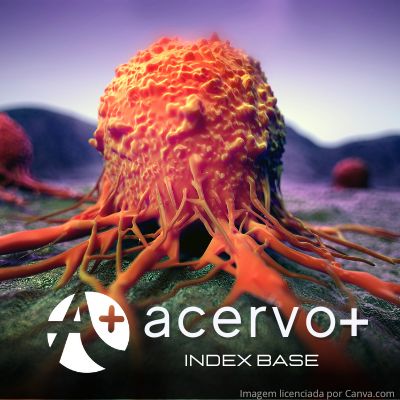Tumor cerebral infantil: uma revisão narrativa
##plugins.themes.bootstrap3.article.main##
Resumo
Objetivo: Evidenciar dados da literatura com a temática de tumores cerebrais infantis com o intuito de ampliar, atualizar e fomentar os estudos científicos na área. Revisão bibliográfica: Os tumores cerebrais na idade pediátrica apesar de raros são a segunda neoplasia mais predominante e podem ocasionar sequelas que persistem ao longo da vida. As variações histológicas denominam vários subtipos de tumores cerebrais e caracterizam aumento da massa anormal de células no cérebro geralmente associadas a síndromes ou a genéticas. Os sinais e sintomas são inespecíficos e comuns em outras patologias, o que dificulta o diagnóstico imediato. Os exames mais indicados para a confirmação da neoplasia são a tomografia computadorizada e ressonância magnética que identificam as características e localização do tumor. O tratamento da patologia depende das características do tumor e pode ser feito através da ressecção cirúrgica, quimioterapia e radioterapia. Considerações finais: Ficou evidente, portanto, que os tipos mais comuns de tumores cerebrais na infância são: gliomas e meduloblastoma, enquanto os mais raros são: os do sistema nervoso central. Além disso, evidenciou que o prognóstico favorável está ligado ao diagnóstico precoce que dependem da capacitação dos profissionais e do suporte dos centros de saúde para realizar os exames de imagens.
##plugins.themes.bootstrap3.article.details##
Copyright © | Todos os direitos reservados.
A revista detém os direitos autorais exclusivos de publicação deste artigo nos termos da lei 9610/98.
Reprodução parcial
É livre o uso de partes do texto, figuras e questionário do artigo, sendo obrigatória a citação dos autores e revista.
Reprodução total
É expressamente proibida, devendo ser autorizada pela revista.
Referências
2. ALVES SWE, et al. Alterações neuropsicológicas tardias em crianças com tumores cerebrais de fossa posterior. Neuropsicología Latinoamericana, 2020; 12(3): 30-40.
3. BRASIL. Ministério da Saúde, Instituto Nacional de Câncer (INCA). Câncer Infanto-juvenil. 2022. Disponível em: https://www.inca.gov.br/tipos-de-cancer/cancer-infantojuvenil. Acessado em: 10 de maio de 2022.
4. BANDEIRA VHR, et al. Meduloblastoma em uma criança: relato de um caso raro. Brazilian Journal of Health Review, 2019; 2(1): 375-377.
5. CACCIOTTI C, et al. Advances in the molecular classification of pediatric brain tumors: a guide to the galaxy. The Journal of Pathology, 2020; 251(3): 249-261.
6. CARVALHO WMO, et al. Aspectos epidemiológicos do câncer infantojuvenil em uma capital do nordeste brasileiro. Revista Eletrônica Acervo Saúde, 2020; 12(11): e4045.
7. COSTA EFF, et al. O desenvolvimento de tumores cerebrais em idade pediátrica. Revista Eletrônica Acervo Enfermagem, 2021; 10: e6965.
8. FERREIRA ES, et al. Sintomas do câncer infanto-juvenil. Revista Sou Enfermagem, 2017; 1(4): 18-56.
9. GIRARDI F, et al. Worldwide trends in survival from common childhood brain tumors: a systematic review. Journal of global oncology, 2019; 5: 1-25.
10. IUCHNO CW, CARVALHO GP. Toxicidade e efeitos adversos decorrente do tratamento quimioterápico antineoplásico em pacientes pediátricos: revisão integrativa. Ciência & Saúde, 2019; 12(1): e30329.
11. LAPA JDS, et al. Caracterización clínica-epidemiológica y seguimiento de niños con tumores del sistema nervioso central. Revista Chilena de Neurocirugía, 2018; 44(2): 145-149.
12. LIMA MG, et al. Epidemiologia dos tumores do sistema nervoso simpático na população infanto-juvenil em Sergipe: uma análise de 18 anos. Research, Society and Development, 2021; 10(11): e536101120013.
13. LOUIS DN, et al. The 2016 World Health Organization classification of tumors of the central nervous system: a summary. Acta neuropathologica, 2016; 131(6): 803-820.
14. MASCARENHAS LR, et al. Segmentação automática de tumores cerebrais em imagens de ressonância magnética. Einstein (São Paulo), 2020; 18: eao4948.
15. MELCHER V, et al. The Growing Relevance of Immunoregulation in Pediatric Brain Tumors. Cancers, 2021; 13(22) 5601-5621.
16. MOTA ALC, et al. Distribuição da Mortalidade Infantojuvenil por Tumores do Sistema Nervoso Central no Estado do Ceará. Revista Brasileira de Cancerologia, 2022; 68(2): e252134.
17. MURASE MS, et al. Medulloblastoma in older adults: a case report and literature review. World Neurosurgery, 2018; 117: 25-31.
18. OLIVEIRA AT, et al. Perfil epidemiológico do câncer infantil na Paraíba. Revista Eletrônica Acervo Saúde, 2019; 11(16): e1568.
19. OSTROM QT, et al. Epidemiology of Brain and Other CNS Tumors. Current Neurology and Neuroscience Reports, 2021; 21(12): 1-12.
20. PERFEITO RS, DE FARIA ES. Astrocitoma pilomixoide infanto juvenil: principais características, sintomas e tratamentos fisioterapêuticos. Revista Brasileira de Reabilitação e Atividade Física, 2021; 10(2): 1-9.
21. SANTOS CCT, et al. Astrocitoma infantil grau ii e o defict da mímica facial. Revista JRG de Estudos Acadêmicos, 2018; 1(3): 103-108.
22. SANTOS YO, et al. Caracterização de sinais e sintomas de câncer infantojuvenil: A percepção dos pais de acometidos. Research, Society and Development, 2021; 10(9): e7810917828.
23. SCHOLTES C, et al. Health status, health-related quality of life, and socioeconomic outcome in childhood brain tumor survivors: a German cohort study. Neuro-oncology, 2019; 21(8): 1069-1081.
24. VALENTE RG, et al. Mapeamento das principais neoplasias infantojuvenis nas regionais de saúde do Rio de Janeiro. Rev. Pesqui. (Univ. Fed. Estado Rio J., Online), 2020; 12: 1081-1086.
25. YE ZS, et al. Diffusion histology imaging differentiates distinct pediatric brain tumor histology. Scientific reports, 2021; 11(1): 1-12.

